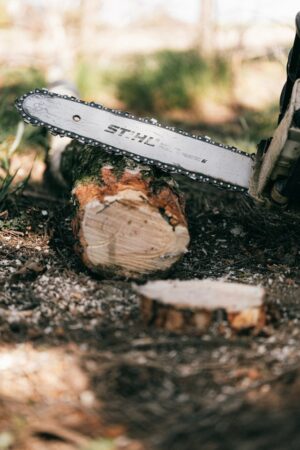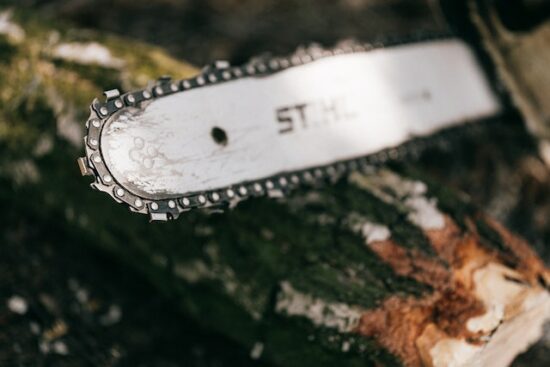If you need to replace a chainsaw bar, it’s critical that you purchase the correct size and specs. It won’t fit if you obtain a new bar that is either too big or too tiny!
We’ll talk about how to measure chainsaw bars in this blog post and offer some advice on how to acquire the ideal measurement. We’ll also go through the things you should think about when selecting the chainsaw bar size.
Therefore, be sure to read this blog post whether you are a professional logger or just someone who enjoys doing occasional DIY tasks around the house.
Table of Contents
How To Measure a Chainsaw Bar
- Pick up a measuring tape, and position the tip of the tape where the bar enters the chainsaw.
- Note the measurement after extending the tape measure to the extreme end of the bar.
- To the nearest even number, round that measurement up. (For example, 16 inches would be rounded up from 15 and 1/2 inches.
Always err on the side of caution while measuring, and choose the larger size. When the time comes to purchase a new chainsaw bar, you can be confident that you are obtaining a replacement that is the right size.
Measurements For Chainsaw Bars

You must learn how to measure a chainsaw bar before you can choose the proper size replacement bar or chain.
There are two methods for determining the guide bar of your saw’s length.
The first method involves taking a measurement from the tip of the snout to the tail’s end.
The second method involves taking measurements between the drive link’s ends.
What size chainsaw do I need for cutting trees? is a fascinating read.
Where to Find Chainsaw Bar Dimensions
The owner’s manual of your chainsaw should be your first stop when trying to ascertain the size of the bar. Frequently, the product information section will contain the bar length. Check under the technical details or features if it isn’t there.
On the chainsaw itself is an excellent spot to look as well. Many producers may directly stamp the size onto the bar. This is particularly typical in electric models.
Use a tape measure or ruler to take your own measurements if you can’t find a reference to the size anywhere.
Factors to Take Into Account When Measuring Chainsaw Bars
When measuring your chainsaw bar, there are a few key considerations that you must make. In order to ensure that you always get an accurate measurement, we’ll go into greater detail about each one in this section.
The pitch of your chain is the first thing you need to know. The distance between any three rivets, multiplied by two, is known as the pitch. Knowing this is crucial since it affects the gauge, or thickness, of the bar.
Usually, the chain itself has this information stamped right there. If not, check your owner’s manual or ask a hardware shop salesperson for assistance in figuring out the pitch of your specific model.
After determining the pitch, you can measure the bar’s actual length and width.
It’s time to learn about the many kinds of bars that are available now that you know how to measure your chainsaw bar. The three most popular varieties of chainsaw bars and the optimal applications for each will be covered in the next section. Remain tuned!
Chainsaw Bar Types
Chainsaw bars come in three different varieties: solid, sprocket-nose, and double-ended. Your choice of bar will depend on the size and power of your saw, the kind of wood you’ll be cutting, and other factors. Let’s examine each one in more detail.
Strong Bars
A solid bar is exactly what it sounds like: a single, unmoving piece of metal. These bars are the heaviest, but they are also the most resilient and long-lasting. They are therefore mostly utilized on larger, more potent saws.
Skeleton-Nose Bars
A tiny wheel with teeth, or sprocket, is attached to the end of a sprocket-nose bar. This kind of bar is lighter than a solid bar and is simpler to handle as a result.
Additionally, it is less prone to become blocked by debris such as branches. These bars do, however, deteriorate more quickly than solid bars due to the manner the sprocket is made.
How to Cut a 135 Degree Angle with a Miter Saw is a fascinating read.

Two-Ended Bars
Two solid bars are simply joined together in the middle to form a double-ended bar. These bars are not as light as sprocket-nose bars, but they are lighter than solid bars.
Additionally, they are less likely to jam than sprocket-nose bars and more resilient. They can be trickier to move in small areas though.
Now that you know the different types of chainsaw bars available, you can start shopping for a replacement bar for your saw.
Chainsaw Bar Measuring: 8 Tips And Tricks
Most people believe that determining the chainsaw chain pitch is rather simple; all you need is a tape measure. There is, however, a little bit more to it than that. Here are eight pointers for accurately measuring your chainsaw bar:
First, consult the owner’s manual:
Check the owner’s manual that came with your chainsaw body as your initial step. The manufacturer will frequently provide detailed guidelines on how to measure the chainsaw bar groove.
Step 2: Tape Measure or Ruler:
Use a ruler or tape measure to cut length effectively if the owner’s manual is silent on particular cutting directions.
Simply extend it out to the entire chain bar’s length and note the necessary length measurement.
7 Best Saw Blades for Cutting Hardwood Flooring is an additional worthwhile read.
Step 4: Take an end-to-end measurement:
Take multiple measurements in Step 6:
Taking several measurements and then averaging them is always a smart idea. This will assure precision.
Write down the measurement in Step 7:
Make careful to record your final measurement somewhere once you get it. In this manner, you’ll always be aware of the size bar you require while placing replacement orders or doing maintenance.
Bring the saw to the store in Step 8:
It’s usually best to bring your chainsaw with you to the store when you’re prepared to get a new bar. In this manner, you can guarantee that the bar fits perfectly.
You’ll be able to measure your chainsaw bar accurately each time by remembering these eight suggestions. You may be sure that your saw will always operate at its peak performance with precise measurements.
Safety precautions for chainsaw measurements:
It is crucial to take some precautions before you start measuring the chainsaw’s bar.
When measuring the chainsaw blade length, make sure the chainsaw is off and that the chain is not engaged. Second, put on gloves to shield your hands from the saw’s razor-sharp edges, and observe all other safety instructions.
Third, while the bar is still on the saw, measure it. This will guarantee that the chainsaw’s bar is measured precisely.
Fourth, measure the bar with a ruler or tape measure. Avoid trying to estimate the chain measurements by eye as this could result in errors.
Fifth, record the measurement so you can refer to it in the future.
Sixth, after measuring the bar to your satisfaction, release the chain and switch off the chainsaw.
Last but not least, be mindful of your surroundings and check to see if there are any nearby people or animals that might be hurt if something goes wrong.
Conclusion
We sincerely hope that this article about measuring chainsaw bars was helpful. It’s essential to accurately measure your chainsaw bar in order to purchase the proper size replacement.


